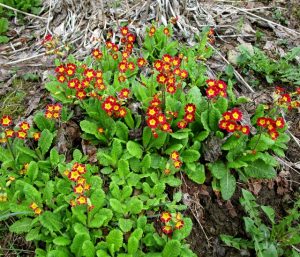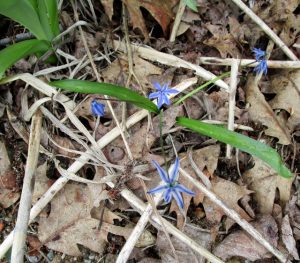 Dedication: This commentary is dedicated to Bamboo, the invasive cat, who kept me up most of last night stalking a rodent that inexplicably wound up in my bedroom. And to get you in the mood to commune with nature, I’ve included a recording of the spring-swollen river flowing and early morning spring birdsong I now hear with one addition. At the beginning of the recording you’ll hear Ollie the dog whimpering pitifully. He’s doing this because Bamboo challenged him when he tried to leave the deck to go into the yard to pee. But eventually Bam got bored and wandered off, freeing Ollie to pee and wander around the yard checking out the flowers (see photos). Eventually, he wandered back to the deck where he remained quietly listening, watching, and smelling spring plus one car going by on the road below until I opened the door… (To get the full-nature effect, I recommend playing the audio attached at the bottom of this page–with the volume up–while you read the rest.)
Dedication: This commentary is dedicated to Bamboo, the invasive cat, who kept me up most of last night stalking a rodent that inexplicably wound up in my bedroom. And to get you in the mood to commune with nature, I’ve included a recording of the spring-swollen river flowing and early morning spring birdsong I now hear with one addition. At the beginning of the recording you’ll hear Ollie the dog whimpering pitifully. He’s doing this because Bamboo challenged him when he tried to leave the deck to go into the yard to pee. But eventually Bam got bored and wandered off, freeing Ollie to pee and wander around the yard checking out the flowers (see photos). Eventually, he wandered back to the deck where he remained quietly listening, watching, and smelling spring plus one car going by on the road below until I opened the door… (To get the full-nature effect, I recommend playing the audio attached at the bottom of this page–with the volume up–while you read the rest.)
This brings me to the subject of this month’s commentary. Over the years, I’ve written a lot about the role of context in animal behavior because context tells us what a behavior means. A behavior without context is like a word without a sentence. Or better yet, a paragraph. Without the context, any behavior could have multiple meanings. But context doesn’t exist in a vacuum any more than behaviors do. Any change in behavior also can change or influence the quality of the human-companion animal bond. While always true, this is especially noticeable during the spring when numerous dog and cat owners learn the power nature wields over animal behavior and their bonds with their animals.
 For some people, the idea that their companion animals’ behavior would be affected by any natural influences seems highly unlikely. Consider the (mis)adventures of Lucy and her cat, Tinabelina, aka Tina. Tina spends her entire life inside Lucy’s home except for infrequent trips to the veterinary clinic. Human and feline live in a closed, climate-controlled environment, i.e., a 6th floor apartment in a multi-storied apartment building amid a cluster of similar structures. The closest Tina gets to nature is a whiff of the bouquet of spring flowers in a vase Lucy placed on the dining room table. Or so Lucy thinks until Tina experiences her first spring as a mature cat.
For some people, the idea that their companion animals’ behavior would be affected by any natural influences seems highly unlikely. Consider the (mis)adventures of Lucy and her cat, Tinabelina, aka Tina. Tina spends her entire life inside Lucy’s home except for infrequent trips to the veterinary clinic. Human and feline live in a closed, climate-controlled environment, i.e., a 6th floor apartment in a multi-storied apartment building amid a cluster of similar structures. The closest Tina gets to nature is a whiff of the bouquet of spring flowers in a vase Lucy placed on the dining room table. Or so Lucy thinks until Tina experiences her first spring as a mature cat.
When that noteworthy spring arrives, Tina begins displaying several behaviors that threaten Lucy’s once blissful relationship with her cat. Tina starts prowling through the apartment in the middle of the night. When she does, sometimes she vocalizes. Although the meows are comparable to those that comprise Tina’s contributions to the “endearing conversations” that Tina and Lucy have shared since Tina was a kitten, Lucy perceives Tina’s nocturnal cries as much louder and far more strident than loving.
Then there’s the couch problem. After reliably using her scratching post for months, that spring Tina starts clawing the couch Lucy saved for months to buy.
“Why aren’t you using your scratching post anymore, you dumb cat!” shouts Lucy angrily. “You’re wrecking my couch!”
But when Tina starts peeing on the welcome mat in the apartment’s entryway, Lucy’s anger gives way to despair.
“Why are you doing this to me?” she sobs to her cat. “I love you so much, but I can’t live like this!”
If we asked Lucy what’s changed in her natural environment, she most likely would answer, “Nothing.” And from her perspective, this is true. Although she’s aware of the seasonal changes and welcomes spring, she equates nature with flowers blooming and an increased songbird population. And because Lucy has experienced more springs in her apartment than her cat, the spring that precipitates Tinabelina’s behavioral meltdown looks and sounds no different from any other.
 From Tina’s perspective, that’s not true at all. Consider what Lucy perceives as her normal springtime routine of opening her rarely opened windows to air out her apartment after a long winter. Many other residents of her pet-friendly complex do likewise. What seems like an inconsequential act to Lucy, introduces Tina to scents that trigger the most primitive parts of her now mature animal brain. Nor are these limited to the scents of the other apartment-dwelling animals carried by the breeze. Although Lucy defines herself as a city-dweller, her area also hosts a population of free-roaming wildlife and domestic animals that would astonish her. And those animals’ scents also reach Tina as she sits on the back of the couch under the open window.
From Tina’s perspective, that’s not true at all. Consider what Lucy perceives as her normal springtime routine of opening her rarely opened windows to air out her apartment after a long winter. Many other residents of her pet-friendly complex do likewise. What seems like an inconsequential act to Lucy, introduces Tina to scents that trigger the most primitive parts of her now mature animal brain. Nor are these limited to the scents of the other apartment-dwelling animals carried by the breeze. Although Lucy defines herself as a city-dweller, her area also hosts a population of free-roaming wildlife and domestic animals that would astonish her. And those animals’ scents also reach Tina as she sits on the back of the couch under the open window.
But Lucy doesn’t realize this because most of these scents are beyond human comprehension. Among them, pheromones communicate messages regarding the species, sex, and reproductive status of cats as well as members of other species. We know Tina possesses the ability to smell these substances. But we don’t know if and how she interprets their messages. Does she leave her claw marks on the couch to signal her ownership of it in response to territorial scent-claims emitted by other animals? Or does she scratch-mark her couch because those potent scents make the highly sheltered, spayed female cat feel anxious because she has no idea what’s going on?
 Either way, when Lucy or any visitors to her home unwittingly walk through pheromone-enriched animal urine as they traverse the green space between the parking lot and her building, any telltale scent on their shoes may wind up on the welcome mat in her entryway. When it does, such blatant violations of her personal space overwhelm Tinabelina. She then urine-marks to signal her determination—if not necessarily her desire—to protect her and Lucy’s home.
Either way, when Lucy or any visitors to her home unwittingly walk through pheromone-enriched animal urine as they traverse the green space between the parking lot and her building, any telltale scent on their shoes may wind up on the welcome mat in her entryway. When it does, such blatant violations of her personal space overwhelm Tinabelina. She then urine-marks to signal her determination—if not necessarily her desire—to protect her and Lucy’s home.
Nature’s influence on the quality of the bonds of companion animals living in suburbia also may fluctuate seasonally, with the arrival of spring often triggering the most dramatic changes. Consider the plight of Cosmo, a 5-year-old neutered male Labrador mix this spring. Over the winter, he gained a few pounds and developed some arthritis in his hips. Additionally, the residential area in which he lives with his people completed an expansion project that included the addition of a dozen new homes plus condominiums. This increased the number of dogs being walked on the sidewalks and also the number of off-lead dogs jogging with their owners on the trails in the surrounding woods. The habitat destruction created by the residential expansion also destabilized the wildlife population. Although some wild animals retreated further into the woods, others attempted to adapt to life in the suburban landscape.
For Cosmo, this spring doesn’t bring a sense of renewal. It brings sensory and territorial chaos and because of his physical limitations, he opts for discretion  over valor. A once-familiar presence on the dog-walk circuit through the neighborhood, this spring he prefers to stick close to home. As in his own yard where he pees and poops as close to the door as he can. He has no desire to broadcast his presence of a willingness to defend his territory to anyone. Nor does he possess any desire to go on long walks on the streets where he’s surrounded by scent-messages from other dogs and an assortment of wildlife threatening him with bodily harm if he violates their space. He will protect himself and (maybe) some key family members if he must. But he has no intention of looking for trouble in his now much more complex environment.
over valor. A once-familiar presence on the dog-walk circuit through the neighborhood, this spring he prefers to stick close to home. As in his own yard where he pees and poops as close to the door as he can. He has no desire to broadcast his presence of a willingness to defend his territory to anyone. Nor does he possess any desire to go on long walks on the streets where he’s surrounded by scent-messages from other dogs and an assortment of wildlife threatening him with bodily harm if he violates their space. He will protect himself and (maybe) some key family members if he must. But he has no intention of looking for trouble in his now much more complex environment.
In some ways, Cosmo’s people have a more difficult time coping with his behavioral changes than Lucy did with Tinabelina’s. Unlike Tina, all Cosmo did was shrink his territory by eliminating closer to the house. However, unlike Lucy’s bond with Tina, much of his people’s bond with him depended on his presence on those daily walks. When the canine cost of these in the expanded and more complex environment exceeded the benefits Cosmo derived from interacting with it on a larger scale, he shrank his territory.
In both of these cases, nature triggered a breakdown in the human-companion animal bond, and the canine and feline responses to those changes were normal for these animals. This doesn’t mean that their behaviors were necessarily acceptable to the people with whom they shared their homes, or even companion animal-owning society in general. Nor does it mean these behaviors can’t be replaced by new animal and human behaviors that would establish a more harmonious human-animal bond. What it does mean is that, regardless how remote we may think our environments are from nature and its influences, even the most human-adapted animal isn’t immune to them.
Podcast: Play in new window | Download
Subscribe: Apple Podcasts | | More
This brings me to the subject of this month’s commentary. Over the years, I’ve written a lot about the role of context in animal behavior because context tells us what a behavior means. A behavior without context is like a word without a sentence. Or better yet, a paragraph. Without the context, any behavior could have multiple meanings. But context doesn’t exist in a vacuum any more than behaviors do. Any change in behavior also can change or influence the quality of the human-companion animal bond. While always true, this is especially noticeable during the spring when numerous dog and cat owners learn the power nature wields over animal behavior and their bonds with their animals.
When that noteworthy spring arrives, Tina begins displaying several behaviors that threaten Lucy’s once blissful relationship with her cat. Tina starts prowling through the apartment in the middle of the night. When she does, sometimes she vocalizes. Although the meows are comparable to those that comprise Tina’s contributions to the “endearing conversations” that Tina and Lucy have shared since Tina was a kitten, Lucy perceives Tina’s nocturnal cries as much louder and far more strident than loving.
Then there’s the couch problem. After reliably using her scratching post for months, that spring Tina starts clawing the couch Lucy saved for months to buy.
“Why aren’t you using your scratching post anymore, you dumb cat!” shouts Lucy angrily. “You’re wrecking my couch!”
But when Tina starts peeing on the welcome mat in the apartment’s entryway, Lucy’s anger gives way to despair.
“Why are you doing this to me?” she sobs to her cat. “I love you so much, but I can’t live like this!”
If we asked Lucy what’s changed in her natural environment, she most likely would answer, “Nothing.” And from her perspective, this is true. Although she’s aware of the seasonal changes and welcomes spring, she equates nature with flowers blooming and an increased songbird population. And because Lucy has experienced more springs in her apartment than her cat, the spring that precipitates Tinabelina’s behavioral meltdown looks and sounds no different from any other.
But Lucy doesn’t realize this because most of these scents are beyond human comprehension. Among them, pheromones communicate messages regarding the species, sex, and reproductive status of cats as well as members of other species. We know Tina possesses the ability to smell these substances. But we don’t know if and how she interprets their messages. Does she leave her claw marks on the couch to signal her ownership of it in response to territorial scent-claims emitted by other animals? Or does she scratch-mark her couch because those potent scents make the highly sheltered, spayed female cat feel anxious because she has no idea what’s going on?
Nature’s influence on the quality of the bonds of companion animals living in suburbia also may fluctuate seasonally, with the arrival of spring often triggering the most dramatic changes. Consider the plight of Cosmo, a 5-year-old neutered male Labrador mix this spring. Over the winter, he gained a few pounds and developed some arthritis in his hips. Additionally, the residential area in which he lives with his people completed an expansion project that included the addition of a dozen new homes plus condominiums. This increased the number of dogs being walked on the sidewalks and also the number of off-lead dogs jogging with their owners on the trails in the surrounding woods. The habitat destruction created by the residential expansion also destabilized the wildlife population. Although some wild animals retreated further into the woods, others attempted to adapt to life in the suburban landscape.
For Cosmo, this spring doesn’t bring a sense of renewal. It brings sensory and territorial chaos and because of his physical limitations, he opts for discretion over valor. A once-familiar presence on the dog-walk circuit through the neighborhood, this spring he prefers to stick close to home. As in his own yard where he pees and poops as close to the door as he can. He has no desire to broadcast his presence of a willingness to defend his territory to anyone. Nor does he possess any desire to go on long walks on the streets where he’s surrounded by scent-messages from other dogs and an assortment of wildlife threatening him with bodily harm if he violates their space. He will protect himself and (maybe) some key family members if he must. But he has no intention of looking for trouble in his now much more complex environment.
over valor. A once-familiar presence on the dog-walk circuit through the neighborhood, this spring he prefers to stick close to home. As in his own yard where he pees and poops as close to the door as he can. He has no desire to broadcast his presence of a willingness to defend his territory to anyone. Nor does he possess any desire to go on long walks on the streets where he’s surrounded by scent-messages from other dogs and an assortment of wildlife threatening him with bodily harm if he violates their space. He will protect himself and (maybe) some key family members if he must. But he has no intention of looking for trouble in his now much more complex environment.
In some ways, Cosmo’s people have a more difficult time coping with his behavioral changes than Lucy did with Tinabelina’s. Unlike Tina, all Cosmo did was shrink his territory by eliminating closer to the house. However, unlike Lucy’s bond with Tina, much of his people’s bond with him depended on his presence on those daily walks. When the canine cost of these in the expanded and more complex environment exceeded the benefits Cosmo derived from interacting with it on a larger scale, he shrank his territory.
In both of these cases, nature triggered a breakdown in the human-companion animal bond, and the canine and feline responses to those changes were normal for these animals. This doesn’t mean that their behaviors were necessarily acceptable to the people with whom they shared their homes, or even companion animal-owning society in general. Nor does it mean these behaviors can’t be replaced by new animal and human behaviors that would establish a more harmonious human-animal bond. What it does mean is that, regardless how remote we may think our environments are from nature and its influences, even the most human-adapted animal isn’t immune to them.
Podcast: Play in new window | Download
Subscribe: Apple Podcasts | RSS | More